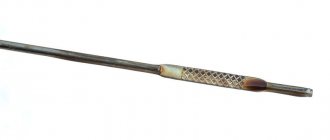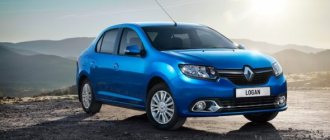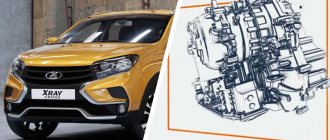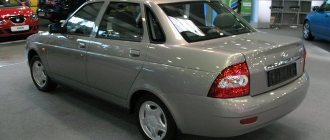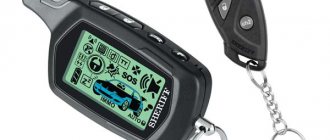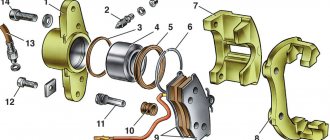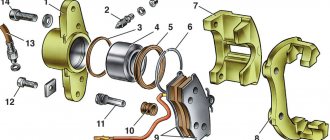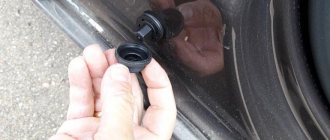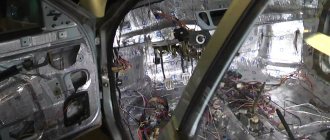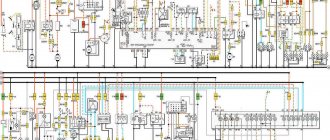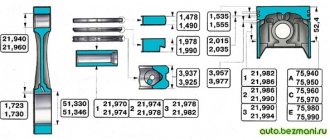Problem 5. AI-92 is allowed, but not for everyone
Some vehicles with H4M are allowed to use AI-92. But gasoline with insufficient octane number is dangerous under severe operating conditions! It’s one thing to “carry” light, single-wheel drive Logans or Vestas, and quite another thing to carry crossovers, and even all-wheel drive ones.
The engine can be combined with a CVT (pictured), automatic and manual transmissions. The engine power on different cars, depending on the firmware of the control unit, is 110–117 hp.
The engine can be combined with a CVT (pictured), automatic and manual transmissions. The engine power on different cars, depending on the firmware of the control unit, is 110–117 hp.
Cause:
the manufacturer adapts to market demands. For many car enthusiasts, the ability to fill the 92nd is very important.
How to fight?
Technical specifications HR16DE 1.6 l/110 l. With.
Initially, the engine was based on an in-line design with overhead camshafts according to the DOHC V16 scheme. The engine layout has been improved with a fluid coupling for variable valve timing, an electronic throttle valve and duplicated injectors on each cylinder.
Attachment layout
Instead of a timing belt, the manufacturer's designers used a high-life chain drive.
Timing chain drive
Initially, the volumes of the combustion chambers were increased to 1.6 liters, and high-life attachments were installed. An important feature of the new power unit is increased efficiency, gasoline savings, high performance and reduced energy losses.
The full technical specifications of the HR16DE are as follows:
| Manufacturer | Atsuta Plant, Nissan Motor Manufacturing UK, Oppama Plant, Nissan Motor Iberica SA, Shonan Plant, AvtoVAZ, Aguascalientes Planta, Dongfeng Motor Company |
| Engine brand | HR16DE |
| Years of production | 2006 – … |
| Volume | 1598 cm3 (1.6 l) |
| Power | 81 kW (110 hp) |
| Torque moment | 153 Nm (at 4400 rpm) |
| Weight | 120 kg |
| Compression ratio | 9,5 |
| Nutrition | injector |
| Motor type | in-line petrol |
| Ignition | COP system, 4 coils on spark plugs |
| Number of cylinders | 4 |
| Location of the first cylinder | TVE |
| Number of valves on each cylinder | 4 |
| Cylinder head material | aluminum alloy |
| Intake manifold | plastic |
| An exhaust manifold | steel welded |
| Camshafts | 8 cams, DOHC design |
| Cylinder block material | Aluminium alloy |
| Cylinder diameter | 78 mm |
| Pistons | aluminum, short skirt |
| Crankshaft | cast iron |
| Piston stroke | 83.6 mm |
| Fuel | AI-95 |
| Environmental standards | Euro 4/5 |
| Fuel consumption | highway – 5.5 l/100 km combined cycle 6.4 l/100 km city – 8.9 l/100 km |
| Oil consumption | maximum 0.5 l/1000 km |
| What kind of oil to pour into the engine by viscosity | 5W30, 5W40, 0W30, 0W40 |
| Which engine oil is best by manufacturer | Liqui Moly, Mobil, Shell, Motul |
| Oil for HR16DE by composition | synthetics, semi-synthetics |
| Engine oil volume | 4.3 l |
| Operating temperature | 95° |
| ICE resource | declared 250,000 km actual 350,000 km |
| Adjustment of valves | washers |
| Cooling system | forced, antifreeze |
| Coolant volume | 6.3 l |
| water pump | GKN-Spidan 91637, Febi 37195, Dolz N151, Blue Print ADN19190 |
| Spark plugs for HR16DE | PLZKAR6A-11 from NGK |
| Spark plug gap | 0,7 |
| Valve train chain | 130281KC0A with two colored marks |
| Cylinder operating order | 1-3-4-2 |
| Air filter | Champion CAF100956P, Bosch F026400101, Blue Print ADN12249, Alco MD-8288 |
| Oil filter | C-207L, C-224, C-221 VIC |
| Flywheel | 6 bolt holes, ring gear complete |
| Flywheel mounting bolts | M12x1.25 mm |
| Valve stem seals | manufacturer Goetze |
| Compression | from 12 bar, difference maximum 1 bar in adjacent cylinders |
| XX speed | 750 – 800 min-1 |
| Tightening force of threaded connections | spark plug – 16 Nm flywheel - 107.8 Nm clutch bolt – 57 Nm bearing cap - 32.4 Nm + 60° (main) and 27.5 Nm, flap, 19.6 Nm + 60° (rod) cylinder head – 66 Nm, weakening, 40 Nm + 75° + 75° |
When making major repairs in a garage with your own hands, the manufacturer recommends using an official manual with detailed instructions for servicing components.
How to extend the life of the N4M motor
One of the most effective ways is to correct your driving style. Anyone who turns the engine a lot and often, allowing strong jerks (on a manual gearbox), will sooner encounter increased oil appetite, chain stretching, and general engine wear.
- Five motors for Vesta: which one you need, find out here.
- Modern additives in fuels and lubricants will help extend the life of any mechanism.
- Products from SUPROTEC and VALENA have proven themselves better than other special additives.
Photo: manufacturing companies
5 problems of the most popular engine Lada, Renault and Nissan
Review of faults and methods for repairing them
When the timing chain links break or jump, the HR16DE motor bends the valve with pistons without counterbores on the end surface. Other malfunctions are usually extraneous sounds:
| Noise inside the timing belt | 1) valve clearances are knocked down 2) wear of the camshaft cams 3) development of valve stems/bushings 4) valve spring is broken 5) reduced oil pressure in the system | 1) adjusting the thermal clearances of the valves 2) replacing the camshaft 3) replacement of valves and bushings 4) installation of a new spring 5) repair or replacement of the oil pump |
| Increased oil consumption | 1) scuff marks on the cylinder bore 2) stuck oil scraper rings | 1) honing cylinders 2) replacing rings |
| Sharp knocking noise at idle when accelerating | 1) wear of connecting rod bearings 2) reduced pressure in the lubrication system | 1) replacement of liners 2) diagnostics, cleaning, oil pump replacement |
| Clunking noise when revving at idle | 1) wear of the main bearings 2) weakening of the flywheel | 1) replacing the liners 2) tightening the fastening bolts |
| Whistling | The alternator belt is loose or overtightened | adjusting tension or replacing the belt |
Repair HR16DE
Manufacturer Nissan has recalled a sold batch of cars due to a defective ignition unit relay. Otherwise, the power drive does not cause any complaints.
Throttle valve
Engines with a significant mileage may have problems starting in sub-zero temperatures. This is quite easy to avoid; just clean the throttle valve from dirt.
Let’s also add that oil deposits in the intake and throttle body arise from the VCG system. And the more and faster the oil deposit appears after cleaning, the greater the wear of the cylinders, or even the mobility of the piston rings may be impaired.
Are you looking for a new throttle body for a Nissan engine, or a throttle body for a Renault engine? We have a suitable model in our catalogue.
Reviews from Nissan Tiida owners
The Tiida model is quite popular among domestic car enthusiasts. In order to understand in more detail how the car behaves in real operation, you can read the reviews of the owners.
Power unit 1.6
- Oleg. Nissan Tiida 1.6 l., 2007, 205,000 km. After overcoming more than two hundred thousand, I can summarize that this is a very high-quality car. I think that I earned my money absolutely honestly. There are some shortcomings, but they do not critically affect the overall operating experience. One of the keys to long and trouble-free operation of the engine is consumables. I only use high quality oil. I refused the original because it coked a lot. Interval 10 thousand. Changed spark plugs every 50 thousand. During the entire period of operation there was no unscheduled work on the engine. All repairs concerned only the chassis. Of the most annoying troubles, I would like to mention belt whistling. But this is a very well-known problem on many Nissans. Otherwise, the car pleases with comfort and trouble-free operation.
- Yuri. Nissan Tiida 1.6 l. 2006 onwards, 235,000 km. At first I didn't like her at all. Even scared me off with its strange design. However, then, out of curiosity, I decided to try to sit down and evaluate it. Then there was a test drive and price comparison with competitors. As a result, the rational approach won and I became the owner of this car. And I will say that after more than ten years of operation I have not regretted it at all. During all this time the car never presented any unpleasant surprises. It always started and went where I wanted. I'm very glad that this engine has a chain. There is no need to constantly think about changing the belt soon. This is important for me because the mileage is relatively large. There were no questions about the engine at all. All work that was performed was only planned. Plus all sorts of related minor work. I cleaned the throttle a couple of times, flushed the fuel system for preventive maintenance, and welded the muffler. The remaining repairs were related only to the replacement of suspension parts. I try to pour high-quality oil and don’t delay the replacement too much. Mostly I change it at 7-8 thousand. After all the years of operation, I am very pleased with this motor. It is enough both in the city and on the highway. Of course, this is not a sports car, but regular overtaking allows you to perform confidently.
Motor 1.8
- Alexander. Nissan Tiida 1.8 l., 2008, 165,000 km. I bought a car with 60 thousand mileage. I drove a little over a hundred myself. At first I didn’t even look in its direction, but then, on the recommendation of a friend, I began to take a closer look at this model. The design is certainly not for everyone, but I really liked everything else. Spacious interior, decent trunk, and most importantly, reasonable price. I wanted the 1.8 engine, because I like it to have power reserves. Impressions from the engine were only positive. On the track I felt very confident. And there were no unpleasant surprises in service. I guess I was lucky, but I practically didn’t eat any oil, although they say that these engines have such an unpleasant feature. I had to change the clutch at 100 thousand, I set it on fire due to carelessness. Only light repairs were performed on the engine. Cleaned the throttle body and washed the injectors. During the time I had the car, I changed two attachment belts. All other work was related only to the replacement of consumables and suspension. Overall, I was happy with the car, and there was no reason to sell it. There was a need for a larger car. I also switched to the Nissan X-Trail and somehow began to trust this brand.
- Dmitriy. Nissan Tiida 1.8 l., 2006, 210,000 km. I chose Tiida after sitting in the salon. None of our classmates offered such space. And the price was very pleasing. So I became the owner of a new Nissan. I had a little doubt about which engine to choose, but it was still decided to go with a more powerful option. From an operational point of view, I was very pleased. Good dynamics and pickup even at high speeds. On the highway I accelerated to 180. But mostly 120-140. For a long time I did nothing at all on the engine. I just changed the oil, filters and other consumables. At 140 thousand the engine began to work strangely. And normal cravings disappeared. At the service station they gave a verdict - the chain had stretched. I had to replace it. The oil has been losing a little since 50 thousand. But just a little. Within a liter per 10 thousand. But after 150 thousand it began to gradually increase. By the time of sale, 210 thousand already had approximately 0.5 liters per 1 thousand km. As I understand it, the problem is in the underlying rings. This is a feature of these engines. Otherwise the car did not cause any problems. A simple and reliable workhorse for every day. There are no frills in it, but it performs its functions quite well.
